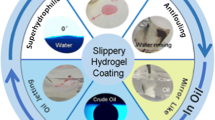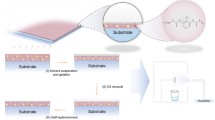Abstract
Traditional lubricant impregnated surfaces usually required fluorinated lubricants to achieve slippery oil repellency, but the lubricants infused were expensive and toxic and also suffered from limited stability because of their migrating, evaporating, and leaking during use. Herein, to address this issue, we fabricated a durably fluorine-free slippery oil-repellent hydrogel coating using water as the lubricant. Due to its enhanced water-binding affinity, water could wet the hydrogel completely and form a hydrated-water layer on the surface. The hydrated water layer could act as a lubricant to repel foreign oils, which allowed the hydrogel to display slippery oil-repellency in air, exhibit superoleophobicity underwater, and resist oil fouling upon oil immersion. The hydrogel kept its oil-repellent properties after mechanical tests as well as thermal and freezing treatments, demonstrating its durability. Thanks to its moisture absorption, the water lubricant layer could self-regenerate upon the lubricated water layer depletion through exposure to a humid environment. Exploiting it is water-attracting and oil repellency, the hydrogel coating was demonstrated as a versatile platform for oil/water separation, polymer/water separation, drag-reduction, and anti-fogging.
Similar content being viewed by others
References
Sun T, Feng L, Gao X, et al. Bioinspired surfaces with special wettability. Acc Chem Res, 2005, 38: 644–652
Zhang X, Shi F, Niu J, et al. Superhydrophobic surfaces: From structural control to functional application. J Mater Chem, 2008, 18: 621–633
Roach P, Shirtcliffe N J, Newton M I. Progess in superhydrophobic surface development. Soft Matter, 2008, 4: 224–240
Zhu X, Zhang Z, Xu X, et al. Rapid control of switchable oil wettability and adhesion on the copper substrate. Langmuir, 2011, 27: 14508–14513
Ge B, Han L, Liang X, et al. Fabrication of superhydrophobic Cu-BiOBr surface for oil/water separation and water soluble pollutants degradation. Appl Surf Sci, 2018, 462: 583–589
Ge B, Han L, Gao B, et al. A mesoporous SiO2/TiO2 composite used for various emulsions separation. Separation Sci Tech, 2019, 54: 962–969
Miao X, Han L, Wang L, et al. Preparation of PDVB/TiO2 composites and the study on the oil-water separation and degradation performances. Sci China Tech Sci, 2019, 62: 1217–1223
Yang J, Song H, Yan X, et al. Superhydrophilic and superoleophobic chitosan-based nanocomposite coatings for oil/water separation. Cellulose, 2014, 21: 1851–1857
Yin K, Du H, Dong X, et al. A simple way to achieve bioinspired hybrid wettability surface with micro/nanopatterns for efficient fog collection. Nanoscale, 2017, 9: 14620–14626
Yin K, Dong X, Zhang F, et al. Superamphiphobic miniature boat fabricated by laser micromachining. Appl Phys Lett, 2017, 110: 121909
Cassie A B D, Baxter S. Wettability of porous surfaces. Trans Faraday Soc, 1944, 40: 546–551
Wenzel R N. Resistance of solid surfaces to wetting by water. Ind Eng Chem, 1936, 28: 988–994
Quéré D. Wetting and roughness. Annu Rev Mater Res, 2008, 38: 71–99
Bocquet L, Lauga E. A smooth future? Nat Mater, 2011, 10: 334–337
Verho T, Bower C, Andrew P, et al. Mechanically durable super-hydrophobic surfaces. Adv Mater, 2011, 23: 673–678
Poetes R, Holtzmann K, Franze K, et al. Metastable underwater superhydrophobicity. Phys Rev Lett, 2010, 105: 166104
Wong T S, Kang S H, Tang S K Y, et al. Bioinspired self-repairing slippery surfaces with pressure-stable omniphobicity. Nature, 2011, 477: 443–447
Kim P, Wong T S, Alvarenga J, et al. Liquid-infused nanostructured surfaces with extreme anti-ice and anti-frost performance. ACS Nano, 2012, 6: 6569–6577
Li H, Feng X, Peng Y, et al. Durable lubricant-infused coating on a magnesium alloy substrate with anti-biofouling and anti-corrosion properties and excellent thermally assisted healing ability. Nanoscale, 2020, 12: 7700–7711
Wang X Q, Gu C D, Wang L Y, et al. Ionic liquids-infused slippery surfaces for condensation and hot water repellency. Chem Eng J, 2018, 343: 561–571
Zhang J, Gu C, Tu J. Robust slippery coating with superior corrosion resistance and anti-icing performance for AZ31B Mg alloy protection. ACS Appl Mater Interfaces, 2017, 9: 11247–11257
Yang J, Song H, Ji H, et al. Slippery lubricant-infused textured aluminum surfaces. J Adhes Sci Tech, 2014, 28: 1949–1957
Dai X, Stogin B B, Yang S, et al. Slippery wenzel state. ACS Nano, 2015, 9: 9260–9267
Li J, Ueda E, Paulssen D, et al. Slippery lubricant-infused surfaces: properties and emerging applications. Adv Funct Mater, 2019, 29: 1802317
Miao S S, Wang Y, Zhao Y J, et al. Bio-inspired slippery surfaces with multifunctional anti-icing performance. Sci China Tech Sci, 2021, 64: 2110–2118
Liu H, Huang J, Li F, et al. Multifunctional superamphiphobic fabrics with asymmetric wettability for one-way fluid transport and templated patterning. Cellulose, 2017, 24: 1129–1141
Zhang J, Seeger S. Superoleophobic coatings with ultralow sliding angles based on silicone nanofilaments. Angew Chem Int Ed, 2011, 50: 6652–6656
Huang W P, Chen X, Hu M, et al. Patterned slippery surface through dynamically controlling surface structures for droplet microarray. Chem Mater, 2019, 31: 834–841
Lu J, Gao Z, Xu T, et al. Robust hydrogel coating with oil-repellent property in air, water, and oil surroundings. ACS Appl Mater Interfaces, 2020, 12: 49138–49145
Wang P, Chen M, Han H, et al. Transparent and abrasion-resistant superhydrophobic coating with robust self-cleaning function in either air or oil. J Mater Chem A, 2016, 4: 7869–7874
Shome A, Das A, Rawat N, et al. Reduction of imine-based cross-linkages to achieve sustainable underwater superoleophobicity that performs under challenging conditions. J Mater Chem A, 2020, 8: 15148–15156
Yu S, Chen W, Wang Y, et al. Nacre-inspired biomineralized mesh toward scalable and robust oil-water separation with high efficiency. Adv Mater Interfaces, 2021, 8: 2100852
Wang C, Zhang F, Yu C, et al. Durable underwater superoleophobic coatings via dispersed micro particle-induced hierarchical structures inspired by pomfret skin. ACS Appl Mater Interfaces, 2020, 12: 42430–42436
Li Q Y, Xu Z Y, Zhang D F, et al. T-shaped trifunctional crosslinker-toughening hydrogels. Sci China Tech Sci, 2020, 63: 1721–1729
Zhang W, Wang D, Sun Z, et al. Robust superhydrophobicity: mechanisms and strategies. Chem Soc Rev, 2021, 50: 4031–4061
Liu M, Li J, Hou Y, et al. Inorganic adhesives for robust superwetting surfaces. ACS Nano, 2017, 11: 1113–1119
Wang Q L, Zhu L, Wei D D, et al. Near-infrared responsive shape memory hydrogels with programmable and complex shape-morphing. Sci China Tech Sci, 2021, 64: 1752–1764
Barba M I, Larrechi M S, Coronas A. Quantitative analysis of the hydration of lithium salts in water using multivariate curve resolution of near-infrared spectra. Anal Chim Acta, 2016, 919: 20–27
Mähler J, Persson I. A study of the hydration of the alkali metal ions in aqueous solution. Inorg Chem, 2012, 51: 425–438
Sui X J, Guo H S, Cai C C, et al. Ionic conductive hydrogels with long-lasting antifreezing, water retention, and self-regeneration abilities. Chem Eng J, 2021, 419: 129478
Wang J Y, Liu J Y, Wang R Z, et al. Experimental investigation on two solar-driven sorption based devices to extract fresh water from atmosphere. Appl Therm Eng, 2017, 127: 1608–1616
Wang X, Li X, Liu G, et al. An interfacial solar heating assisted liquid sorbent atmospheric water generator. Angew Chem Int Ed, 2019, 58: 12054–12058
Matsumoto K, Sakikawa N, Miyata T. Thermo-responsive gels that absorb moisture and ooze water. Nat Commun, 2018, 9: 2315
Zhao F, Zhou X, Liu Y, et al. Super moisture-absorbent gels for all-weather atmospheric water harvesting. Adv Mater, 2019, 31: 1806446–1806452
Pu S, Fu J, Liao Y, et al. Promoting energy efficiency via a self-adaptive evaporative cooling hydrogel. Adv Mater, 2020, 32: 1907307–1907313
Osborne N S, Stimson H F, Ginnings D C. Thermal properties of saturated water and steam. Inorg Chem, 1939, 9: 119–125
Conde M R. Properties of aqueous solutions of lithium and calcium chlorides: Formulations for use in air conditioning equipment design. Int J Therm Sci, 2004, 43: 367–382
Zaoui-Djelloul-Daouadji M, Negadi A, Mokbel I, et al. (Vapor-liquid) equilibria and excess Gibbs free energy functions of (ethanol+glycerol), or (water+glycerol) binary mixtures at several temperatures. J Chem Thermodyn, 2014, 69: 165–171
Author information
Authors and Affiliations
Corresponding authors
Additional information
This work was supported by the Natural Science Foundation of Shandong Province (Grant No. ZR2019MEM044), the National Natural Science Foundation of China (Grant No. 11704321), Yantai Science and Technology Plan Projects (Grant No. 2019XDHZ087), and Graduate Innovation Foundation of Yantai University (Grant No. YDZD2129).
Supporting Information
The supporting information is available online at https://tech.scichina.com and https://link.springer.com. The supporting materials are published as submitted, without typesetting or editing. The responsibility for scientific accuracy and content remains entirely with the authors.
Rights and permissions
About this article
Cite this article
Xu, T., Gao, Z., Li, F. et al. A slippery hydrogel coating with durable oil-repellent property and self-regeneration capacity. Sci. China Technol. Sci. 65, 1819–1827 (2022). https://doi.org/10.1007/s11431-022-2045-6
Received:
Accepted:
Published:
Issue Date:
DOI: https://doi.org/10.1007/s11431-022-2045-6




